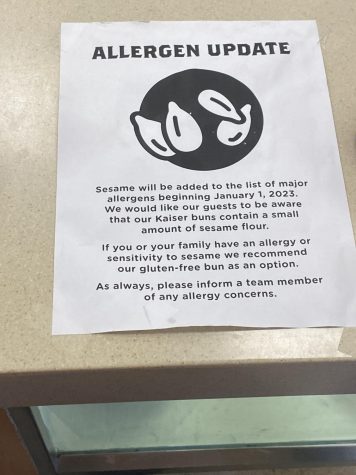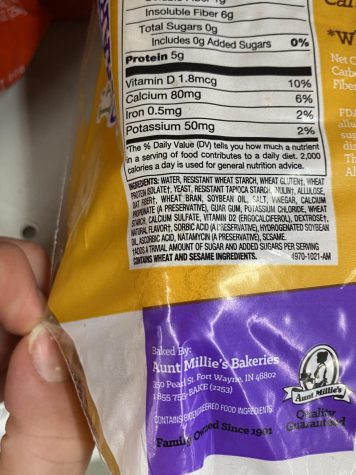Warning About Sesame
February 3, 2023
According to The Hill, about 25% of the U.S. population is impacted by allergies and intolerances, and about 10% of the population can have a potentially fatal reaction. These people depend on homemade meals; they can only go to restaurants if they know their allergens are not present. Unfortunately, there are rapidly decreasing options for the 1.6 million Americans who are allergic to sesame.
On April 23, 2021, the United States Congress signed the FASTER Act, which stands for Food Allergy Safety, Treatment, Education, and Research Act. This adds sesame to the list of major allergens in the U.S., meaning that food producers are required to label anything potentially containing sesame. This also requires businesses to clean any equipment that makes food items containing sesame if it also processes foods without the allergen in order to avoid cross contact.
Cross contact and cross contamination are often confused for each other, but they are not the same. Cross contamination occurs when bacteria and other microorganisms transfer from foods containing them, which are usually uncooked meats, to foods not containing them, such as non-meat foods or cooked meats, causing those previously clean foods to be contaminated. Cross contact happens when an allergen comes into contact with a food product that would otherwise be safe for a person with that allergy. Cross contamination can often be eliminated by cooking the food, but cross contact stays after the process. However, not everybody with allergies has the same level of sensitivity; some of them may be unaffected by cross contact.
The safest action producers can take is to clean equipment that makes food with sesame to avoid cross contact with any foods that do not. This would continue to provide safe food to people with the allergy. Instead, many manufacturers have chosen to add trace amounts of sesame and change the labels to reflect sesame as a potential ingredient even in foods that did not previously contain the allergen. This choice by manufacturers and restaurants, to label instead of clean, removes several options from the diets of people allergic to sesame, but that is not the only impact.
This problem would not be as bad if the recipe changes were announced publicly. Some restaurants, such as Culver’s, are putting up warning signs at their ordering counters, but they can be easily overlooked. People with allergies and their close relatives know to look closely at ingredients and warning labels, but food caterers or people buying food for a large group of people might not know to check the ingredients.
To be fair, it is not entirely the fault of restaurants. It is the companies that provide food to those restaurants that are mostly to blame. While the restaurants cook and prepare the food, they are not present at the business providing them with food to control which products contain which allergens.
This does not mean that restaurants are completely innocent, either. They could have chosen to partner with a company that produces food in a safe allergen-free environment. In an interview with BuzzFeed News, a mother of a child with many allergies said, “It’s 2022! We can make meat-free ‘meat,’ eggless ‘omelets,’ gluten-free baguettes, and dairy-free ice cream, but these fast-food titans can’t find a baker who can bake a sesame-free bun?”
There are several restaurants that made the unfortunate change to add sesame to their ingredients. Some restaurants that have done this include nationwide chains like Chick-Fil-A, Wendy’s, Culver’s, Olive Garden, McDonald’s, and Domino’s. These are not the only restaurants that added sesame. A good rule of thumb is to do research; look up the allergen menus for any restaurants about which you are unsure.
An FDA spokesperson told BuzzFeed News that, with regard to allergens, labeling is not an equal replacement of good manufacturing practices. Unfortunately, many producers disregard this and change their recipes. Until this issue is resolved, people with sesame allergies should take extra care in choosing what food they eat.
Camero, Katie. “Chick-Fil-A and Other Restaurants Added Sesame to Their Food and People with Sesame Allergies Are Pissed.” BuzzFeed News, BuzzFeed News, 16 Dec. 2022, https://www.buzzfeednews.com/article/katiecamero/chick-fil-a-sesame-allergies?ref=bfbiobuzzfeedtasty&utm_campaign=bfbiobuzzfeedtasty&utm_source=buzzfeed.bio&p_id=112920.
Lisa Gable, opinion contributor. “Passage of FASTER Act Is Critical for Food Allergy Community.” The Hill, The Hill, 6 Apr. 2021, https://thehill.com/blogs/congress-blog/politics/546602-passage-of-faster-act-is-critical-for-food-allergy-community/.
“Nutrition and Allergens.” Chick-Fil-A, Chick-Fil-A, 2022, https://www.chick-fil-a.com/nutrition-allergens.
“Simple a Mindful Choice Is a Choice – Culver’s.” Nutrition & Allergen Guide, Culver’s, 2022, https://cdn.culvers.com/menu/docs/guide-nutrition-allergen.pdf.
“Allergen Information – Olive Garden.” ALLERGEN INFORMATION, Olive Garden, https://media.olivegarden.com/images/site/pdf/allergen_guide.pdf.
Allergen – McDonald’s. McDonald’s, 2023, https://www.mcdonalds.com/content/dam/uk/nfl/pdf/nutrition/allergen-booklet-10022021.pdf.
“List of Allergens – Cache.dominos.com.” LIST OF ALLERGENS, Domino’s, 2021, https://cache.dominos.com/olo/6_66_5/assets/build/market/AT/_en/pdf/allergen.pdf.
U.S. National Debt Clock : Real Time, https://www.usdebtclock.org/.





